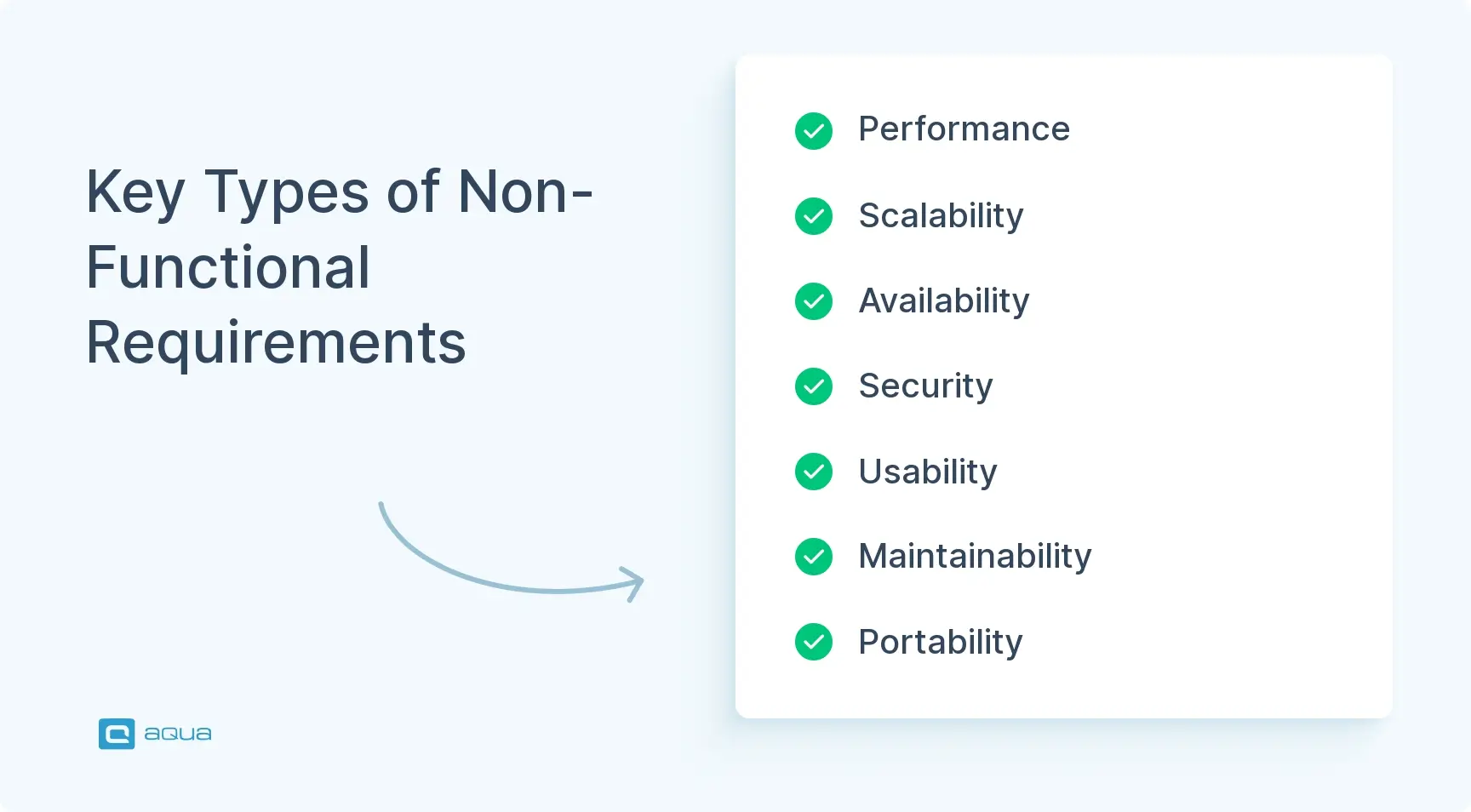Key Takeaways
- Non-functional requirements define how a system performs rather than what it does. It covers aspects like speed, security, reliability, and scalability that determine user experience.
- Industry data shows about 60% of software project failures trace back to inadequate attention to non-functional requirements. 64% of delays stem from overlooked operational specifications.
- Non-functional requirements must be specific and measurable with concrete numbers (e.g., “API response under 200ms for 95% of requests”), not vague statements like “system should be fast.”
- Key types of non-functional requirements include performance, scalability, availability, security, usability, maintainability, compatibility, portability, and reliability.
- Modern tools like aqua cloud, Jama Software, IBM DOORS Next, help teams document, trace, and continuously validate non-functional requirements throughout development.
Ignoring non-functional requirements can lead to catastrophic failures like the London Ambulance Service disaster or Knight Capital’s $440 million trading loss in just 45 minutes. Want to know how to get them right? Check out the detailed guide below 👇
What Are Non-Functional Requirements?
Non-functional requirements specify how well your system performs its job.
Your system uploads photos. Great. But does it upload them in 3 seconds or 30? Does it handle 100 concurrent users or crash at 10? Can it survive a spike in traffic without melting down? Thats what non-functional requirements answer.
Functional requirements tell you what the system does. Non-functional requirements tell you how well it does it. Performance benchmarks. Security protocols. Reliability thresholds. Scalability targets. These requirements shape architecture, inform technology choices, and guide development from day one.
Ignore them and your project tanks. The London Ambulance Service built a dispatch system in 1992 that met every functional requirement on paper. But under real-world load, it collapsed in eight days. Performance and reliability failures killed it. They went back to manual operations.
Non-functional requirements are design constraints that determine whether your system scales gracefully or falls apart under pressure. Get them right, and users stick around. Get them wrong and you will have to rebuild from scratch while competitors take the market.
Comparison of Functional and Non-Functional Requirements
Lets compare the functional and non-functional requirements in a structured way to make the differences even more distinct for you:
When defining non-functional requirements (NFRs), the challenge is to ensure they remain traceable, testable, and integrated throughout your development lifecycle.
| Aspect | Functional Requirements | Non-Functional Requirements |
|---|---|---|
| Definition | What the system does | How the system performs |
| Focus | Features and capabilities | Quality attributes and constraints |
| Examples | “Users can reset passwords” “System generates monthly reports” |
“Password reset completes within 2 seconds” “System handles 10,000 concurrent users” |
| Measurement | Binary (works or doesn’t) | Quantitative metrics (speed, uptime, throughput) |
| Testing Approach | Functional testing, UAT | Performance testing, security testing, load testing |
| Impact of Failure | Feature unavailable | Poor user experience, system instability, security breaches |
This is where aqua cloud shines. Non functional requirements need consistent tracking and testing throughout development. aqua cloud connects your NFRs directly to test cases, execution results, and defects. The platform’s hierarchical structure organizes performance, security, and reliability requirements with precision. AI powered assistance generates test scenarios directly from your documented NFRs. aqua’s domain-trained AI Copilot learns from your project documentation. Every generated test stays relevant to your specific non-functional criteria instead of producing generic outputs. Security, performance, and usability requirements translate into meaningful test coverage that validates your quality attributes. The platform generates test cases, requirements, and test data in seconds with 100% AI powered generation. Complete traceability connects every requirement to tests and defects, ensuring nothing falls through cracks. Integrations with Jira, Confluence, and Azure DevOps keep your entire workflow synchronized. Your NFR documentation becomes actionable test coverage that actually validates system quality.
Transform your NFR documentation into actionable test coverage with aqua's AI-powered platform
Types of Non Functional Requirements
Non-functional requirements cover different aspects of system quality and performance. Understanding these types helps you ensure comprehensive coverage in development.

Performance Requirements
Performance requirements define how fast your system responds and processes work. Response time shows how long users wait for actions to complete. Throughput measures how many transactions the system handles per second. Resource consumption tracks CPU, memory, and bandwidth usage. These are the concrete targets with specific numbers attached.
An e-commerce checkout shouldn’t take longer than 2 seconds to process payment confirmations. Search results should appear within 500 milliseconds. API endpoints need sub-100ms response times for real-time applications. Amazon discovered that every 100 milliseconds of latency costs them 1% in sales. By 2017, studies showed every 100-millisecond delay hurts conversion rates by 7%.
Performance requirements also cover peak load scenarios. Your system might handle 100 users fine. But what happens when Black Friday traffic hits and you’re suddenly dealing with 10,000 concurrent sessions? PriceRunner managed 5 to 8 millisecond response times during 20x normal traffic with 100 million concurrent price updates. Without clear performance NFRs, you’re guessing. Guessing wrong costs you customers and revenue.
Scalability Requirements
Scalability determines how well your system grows with demand. Vertical scaling adds more power to existing servers. Horizontal scaling adds more servers to distribute the load. Modern cloud native architectures lean toward horizontal scaling because it’s more flexible and cost-effective.
Your NFRs need to specify scaling triggers and capacity targets. The system must automatically spin up additional server instances when CPU utilization exceeds 70% and scale back down when it drops below 40%. Platform must handle traffic increases of 200% during promotional events without degrading response times. These requirements inform architectural decisions early. Building for horizontal scaling? You need stateless services, distributed caching, and load balancers from the start.
Elasticity ties into this. Your system needs to scale up and down automatically based on demand. Cloud providers make this easier, but you still need to define the rules. Scalability NFRs prevent scenarios where companies project 100 concurrent users but actually need to support 1,000, resulting in $300,000 in unplanned spending and four month delays to fix the mess after launch.
Availability Requirements
Availability defines how reliably your system stays operational. It’s typically expressed as uptime percentages.
A 99.9% availability target sounds great until you realize that’s still 8.76 hours of downtime per year. For critical systems, you need 99.95% (4.38 hours per year) or even 99.99% (52.56 minutes per year). Each additional nine gets exponentially harder and more expensive to achieve.
These requirements shape:
** Disaster recovery strategies
** Redundancy architectures
** Failover mechanisms.
You need to specify maximum downtime tolerances and recovery time objectives. System must automatically fail over to the backup data center within 60 seconds of primary failure. Maximum unplanned downtime per month: 30 minutes.
Healthcare systems handling patient care need 99.9% uptime minimum because lives depend on it. Financial trading platforms demand even tighter targets because seconds of downtime translate to millions in lost transactions.
Availability NFRs also cover maintenance windows. Can you take the system offline for updates, or do you need zero-downtime deployment strategies like blue-green deployments or rolling updates? These questions need answers before you write code, not when you’re scrambling to patch a security hole without interrupting service.
Performance, reliability, availability, security.
These are minimum NFRs.
However, I learned over the years to guage each of them against user tolerance.
What is the point at which users complain things are slow? Spec a bit higher so performance constraints are quantified and qualified.
Same with the others.
Portability Requirements
Portability describes how easily your software runs across different platforms, operating systems, browsers, or devices. NFRs here specify compatibility targets. Application must run on Windows 10+, macOS 11+, and Ubuntu 20.04+ without modification. Web interface must support Chrome, Firefox, Safari, and Edge (last two major versions).
Mobile apps face portability challenges around screen sizes, operating system versions, and device capabilities.
Your NFRs might state: Mobile app must function on iOS 14+ and Android 10+, supporting screen sizes from 4.7 to 6.7 inches with responsive layouts. Cloud portability matters too. Can your application move between AWS, Azure, and Google Cloud without major rewrites? Container based architectures using Docker and Kubernetes improve portability, but you still need to define expectations upfront.
Portability requirements influence technology stack choices. Cross-platform desktop apps matter? You might choose Electron or a similar framework.
Browser compatibility matters? You avoid bleeding edge JavaScript features that aren’t universally supported. These decisions cascade through your architecture, so portability NFRs need clarity from day one.
Compatibility Requirements
Compatibility focuses on how well your system works with other software, legacy systems, APIs, or hardware. These requirements specify integration points and interoperability standards. System must integrate with Salesforce via REST API with OAuth 2.0 authentication. Payment processing must support Stripe, PayPal, and Square APIs.
Healthcare applications face serious compatibility challenges. Electronic Health Records systems need to exchange data seamlessly. Standards like FHIR (Fast Healthcare Interoperability Resources) enable this. Your NFRs might specify: Application must expose FHIR-compliant APIs for patient data exchange. System must integrate with existing EHR platforms, including Epic, Cerner, and Allscripts. Without these requirements defined early, you build isolated systems that can’t communicate. Compatibility testing methods help verify these integrations work correctly.
Backward compatibility matters when you’re updating existing systems. Your NFRs should clarify whether new versions need to support old data formats, APIs, or client applications. Breaking backward compatibility might be acceptable in some contexts but catastrophic in others. These decisions need to be intentional, not accidental discoveries during deployment.
Reliability Requirements
Reliability defines how often your system fails and how gracefully it recovers. Metrics like Mean Time Between Failures and Mean Time To Recovery measure this. A reliable system doesn’t crash every time something unexpected happens. It handles errors, logs issues, and keeps running.
Your NFRs might specify: System must maintain 99.95% uptime with automated recovery from single component failures within 30 seconds. Application must handle network interruptions gracefully by retrying failed requests up to three times with exponential backoff. These requirements drive architectural patterns like circuit breakers, bulkheads, and retry logic.
Fault tolerance ties directly into reliability. Can your system detect failures and isolate them before they cascade? When one microservice goes down, does it take the entire platform with it, or do fallback mechanisms kick in?
The London Ambulance Service disaster showed what happens when reliability NFRs get ignored. Memory leaks consumed server resources. The system couldn’t handle the expected loads. The whole thing collapsed during normal operations. Defining reliability requirements means thinking through failure scenarios and planning responses, not hoping everything works perfectly forever.
Maintainability Requirements
Maintainability determines how easily developers can update, fix, or extend your system. Code quality, documentation, modular architecture, and development practices all factor in. NFRs here might specify: All public APIs must include comprehensive documentation with code examples. Code must maintain a minimum of 80% test coverage with automated CI/CD pipelines.
These requirements influence daily development work. Maintainability matters? You’re enforcing coding standards, conducting code reviews, and building modular architectures that isolate changes. Poorly maintained systems turn into legacy nightmares where every bug fix breaks three other things, and adding features takes months instead of days.
Structured logging and observability fall under maintainability. Your NFRs should specify logging formats, error tracking integrations, and monitoring dashboards. Application must output JSON-formatted structured logs with request IDs, timestamps, and severity levels. The system must integrate with monitoring tools, providing real-time alerting on error rate thresholds. Cloud native applications need readiness probes for Kubernetes orchestration and health check endpoints for load balancers. These aren’t optional extras. They’re fundamental requirements that determine operational efficiency.
Security Requirements
Security requirements protect data, prevent unauthorised access, and ensure compliance with regulations. They’re non-negotiable in modern software development. Data breaches destroy trust and trigger massive legal and financial consequences. Your NFRs need to specify encryption standards, authentication mechanisms, access controls, and compliance frameworks.
All data in transit must use TLS 1.3 encryption. All personally identifiable information at rest must use AES 256 encryption. Authentication requirements: System must enforce multi factor authentication for all administrative accounts. Password policies must require minimum 12 characters with complexity requirements and 90 day rotation. Access control NFRs define role based permissions: System must implement role based access control with granular permissions audited quarterly.
Compliance adds complexity. Healthcare apps need HIPAA compliance:
- Encryption
- Audit trails
- Role-based access control
- Breach notification capabilities
Financial services face GLBA safeguards and SOX compliance for financial reporting. E-commerce platforms handling payments must meet PCI DSS standards. GDPR applies to any system processing European user data, requiring data minimization, user access rights, and breach notification protocols. Your security NFRs need to explicitly reference applicable regulations and describe how the system achieves compliance. Vague statements like “must be secure” don’t cut it. You need specific, testable criteria. Security testing with AI can enhance security measures.
Usability Requirements
Usability defines how easily users accomplish their goals. Interface design, accessibility, learnability, and overall user experience all matter. These requirements might specify: New users must complete core workflows without training or documentation. Application must achieve System Usability Scale scores above 80 in user testing.
Accessibility is increasingly critical, both legally and ethically. Your NFRs should reference standards like WCAG (Web Content Accessibility Guidelines): Web interface must achieve WCAG 2.1 Level AA conformance.
Application must support screen readers and keyboard-only navigation. High contrast modes, adjustable font sizes, and alternative text for images expand your user base and keep you compliant with accessibility laws. Usability testing basics help ensure these standards are met.
Learnability metrics matter too. If it takes users 30 minutes to figure out basic features, you’ve got usability problems. NFRs might specify: 80% of users must successfully complete checkout process within 3 minutes on first attempt. Help documentation must reduce support ticket volume by 40% within three months of deployment. These requirements shape interface design, information architecture, and user testing strategies. Usability isn’t subjective. It’s measurable, testable, and directly impacts user satisfaction and retention.
Practical Examples of Non Functional Requirements
Here’s how non-functional requirements work in real projects across different industries.
E-Commerce Platform
An online retailer launching a new marketplace needs to compete hard. Their performance NFRs specify page load times under 2 seconds for 95% of users. The system must scale to handle 200% traffic spikes during Black Friday and other promotional events. Availability targets hit 99.95% uptime with automatic failover between redundant data centres.
Security requirements mandate PCI DSS compliance for payment processing. All data in transit needs TLS 1.3 encryption. Protection against OWASP Top 10 vulnerabilities is required. When these NFRs are met, the platform handles peak shopping periods smoothly. PriceRunner maintained 5 to 8 millisecond response times during 20x normal traffic. When NFRs get ignored? Crashes, abandoned carts, and revenue lost to competitors.
Financial Trading System
Trading platforms operate in milliseconds. Performance NFRs demand trade execution within sub-100ms timeframes. API response times must stay under 100 milliseconds for customer queries. Reliability requirements specify 99.99% uptime with automatic recovery from single component failures within seconds.
Security NFRs mandate multi-factor authentication and encryption of all financial data. Continuous audit trail logging is required. Compliance with GLBA safeguards and NIST Cybersecurity Framework standards is mandatory. MiFID II regulations add capacity testing requirements. Systems must handle transactions at twice the highest message rates recorded over the previous five years. These are regulatory mandates backed by penalties.
Healthcare Application
A patient portal needs strong security and interoperability. Security NFRs require HIPAA-compliant data encryption with AES 256 for stored data. Role-based access control with granular permissions is mandatory. Comprehensive audit logging tracks all access.
Reliability targets specify 99.9% uptime for patient care systems. Disaster recovery must support a maximum four-hour recovery time objective. Compatibility requirements demand seamless integration with existing EHR platforms via FHIR-compliant APIs. Data exchange across Epic, Cerner, and Allscripts systems must work smoothly. GDPR compliance requirements apply to European patient data, adding data minimization and patient access rights.
When NFRs Get Ignored
Real failures show the stakes. The London Ambulance Service deployed a dispatch system in 1992 that met all functional requirements. It failed catastrophically due to inadequate NFRs. Memory leaks consumed server resources. The system couldn’t handle the expected loads. Location identification failed. The whole thing collapsed after eight days, resulting in late ambulance arrivals and at least one confirmed death.
Knight Capital lost $440 million in 45 minutes during 2012 when faulty software deployed without adequate testing flooded the market with erroneous trades. Amazon outages during peak shopping periods cost millions per minute in lost sales. These aren’t edge cases. They’re what happens when performance, scalability, and reliability NFRs get treated as optional.
Best Practices for Documenting Non Functional Requirements
Writing effective NFRs requires precision, collaboration, and ongoing refinement. Here’s how to get it right.
Be specific and measurable
Vague requirements like “the system should be fast” or “must be secure” are useless. Apply SMART criteria: Specific, Measurable, Achievable, Relevant, and Time bound.
Collaborate with stakeholders
NFRs aren’t purely technical concerns.
Security teams provide input on compliance requirements. Operations teams understand reliability and performance constraints. Business stakeholders define acceptable downtime and budget limits. Users reveal usability expectations through feedback and testing. Cross-functional workshops bring these perspectives together and surface requirements that chaotic teams miss. Walk through peak load conditions, failure scenarios, and edge cases to identify hidden NFRs before they become production emergencies.
Group requirements into categories
Organize NFRs using frameworks like ISO/IEC 25010, which covers performance efficiency, security, reliability, usability, maintainability, and portability. Categorization makes requirements easier to navigate and ensures comprehensive coverage. Each category gets its own section with consistent formatting:
**Requirement ID
**Description
**Priority
**Measurement criteria
**Dependencies
Use consistent formatting and templates
Standardize your NFR documentation with templates that include requirement IDs, descriptions, priority rankings, quantifiable metrics, and acceptance criteria. A non-functional requirements template might include: “ID: NFR SEC 001, Description: Multi-factor authentication required for administrative accounts, Priority: Must have, Metric: 100% of admin logins must complete MFA flow, Acceptance: Security audit confirms zero admin accounts bypass MFA.” Consistency reduces misunderstandings and speeds up reviews.
Reference industry standards and benchmarks
Don’t reinvent the wheel. Use established standards:
**WCAG for accessibility
**PCI DSS for payment security
**ISO 26262 for automotive safety
**FHIR for healthcare interoperability.
These frameworks provide proven criteria and compliance checklists. Benchmarking against competitors or similar systems sets realistic targets. Competitors achieve 99.95% uptime and 2-second page loads? You know what to aim for.
Review and adapt regularly
NFRs aren’t static documents you write once and forget, either. Technology evolves. User expectations shift. Business priorities change. Establish periodic reviews, quarterly or per major release, to validate NFRs against actual system performance and emerging requirements. Continuous monitoring in production provides data on whether you’re meeting targets. User feedback reveals gaps in usability or performance expectations. Treat NFRs as living specifications that mature alongside your product, not fixed constraints.
| Don’t Do | Do |
|---|---|
| fast response times | API endpoints must respond within 200 milliseconds for 95% of requests under normal load (up to 5,000 concurrent users) |
| secure data | all personally identifiable information must use AES 256 encryption at rest and TLS 1.3 in transit, with audit logs retained for seven years |
Tools for Managing Non Functional Requirements
aqua cloud offers a unified approach to NFR management with end-to-end traceability, customizable workflows, and powerful visualization. Every performance target, security protocol, and reliability benchmark becomes trackable and testable within the same platform. With aqua’s domain-trained AI Copilot, you can generate targeted test cases specifically for your NFRs, leveraging your own project’s documentation to create context-aware scenarios. The platform’s visual dependency mapping lets you instantly see which tests verify specific non-functional requirements, while custom dashboards keep stakeholders informed on NFR coverage and compliance in real time. For regulated industries, aqua automatically maintains audit trails and evidence collection, turning manual compliance work into an automated process. When 60% of project failures trace back to inadequate NFR attention, can you afford not to have a specialized solution?
Achieve 100% NFR coverage with context-aware AI and end-to-end traceability in aqua
Modern Requirements4DevOps integrates directly with Azure DevOps, providing requirements traceability, version management, and collaboration features within development pipelines. Built for agile teams needing real-time visibility between service requests and development work.
Jama Software offers live traceability and AI-powered Requirements Quality Intelligence that evaluates requirement clarity in real time. It automatically flags ambiguities and incomplete specifications, helping teams catch issues before they propagate. Strong for complex, regulated product development where compliance and change control matter.
IBM DOORS Next brings comprehensive traceability and configuration management with an AI-enhanced quality assistant that analyzes requirement clarity. Excels in complex engineering projects and safety-critical systems, though it comes with steeper learning curves and higher costs.
Perforce Helix ALM provides modular flexibility with strong compliance support through templates, audit trails, and test integration. Well-suited for regulated industries needing formal requirements management, issue tracking, and compliance documentation in one platform.
Jira Software + Confluence delivers agile flexibility and extensive ecosystem integration. Not purpose-built for requirements management, but custom workflows, marketplace extensions, and native Scrum/Kanban boards make it popular with development-focused organizations. Lacks the formal traceability depth that regulated industries often require.
AI and automation capabilities
Modern platforms use AI to intelligently route requirements, trigger approvals, and flag potential roadblocks. Machine learning based NFR classification achieves precision rates between 81 to 99.8% in automatically categorizing requirements from documents. Large Language Models now generate NFRs automatically from functional requirements using structured prompting aligned with ISO/IEC 25010 standards.
Testing integration
SAST tools examine source code for vulnerabilities. DAST tests running applications. IAST combines both approaches. These integrate directly into CI/CD pipelines, ensuring NFRs around security, performance, and compliance get validated continuously rather than discovered late in testing cycles.
Choose tools based on your context: team size, regulatory environment, existing technology stack, and requirements complexity. Small agile teams might thrive with Jira and Confluence. Regulated industries handling safety-critical systems need the formal rigor of Jama or DOORS Next.
As we’ve seen, non-functional requirements are the difference between software that technically works and software that succeeds in the real world. But managing these requirements effectively requires more than spreadsheets and disconnected tools.
Conclusion
Non-functional requirements determine whether users stick around or leave. Your system can have every feature users asked for. But if it crawls under load, leaks data, or crashes during peak traffic, users leave and competitors win. Document NFRs early. Make them specific and measurable. Test them continuously. The difference between software that ships and software that succeeds comes down to how well it performs, not just what it does.

















